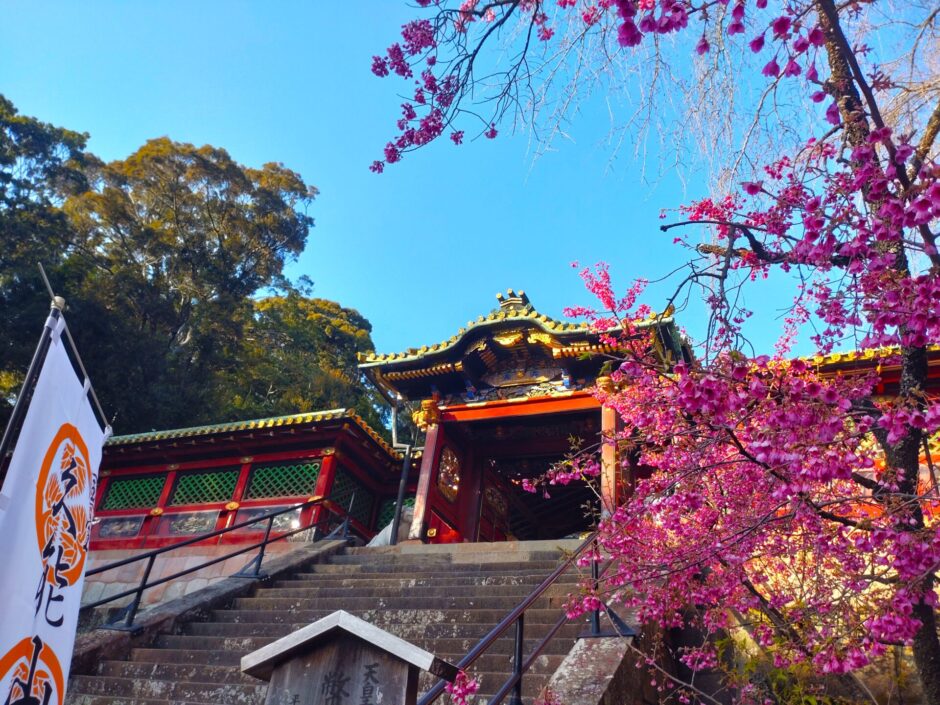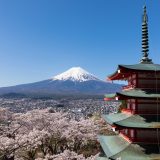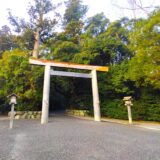【Kunouzan Toshogu Summary】
Kunouzan Toshogu was founded around the 7th century as Kunouji Temple and became a large temple with more than 300 Zen monks during the Kamakura period (1192-1333), but was destroyed by fire. Later, Shingen Takeda moved the Kunouji Temple to this site and made it Kunou Castle, but after the fall of the Takeda clan, it became the property of Ieyasu Tokugawa. After Ieyasu’s death, his remains were buried at Mt. Kunou by order of his father, Kunou Castle was abolished, and the Tosho-sha Shrine (later renamed Toshogu Shrine) was built. History (Temple → Castle → Shrine)
![Kunouzan Toshogu Shrine [Shizuoka] DSC 0206 1024x768 - Kunouzan Toshogu Shrine [Shizuoka]](https://japan-shrine.info/wp-content/uploads/DSC_0206-1024x768.jpg)
There are shrines dedicated to Prince Tokugawa Ieyasu throughout Japan, the first of which is Kunouzan Toshogu Shrine. Kunouzan Toshogu is also the place where Ieyasu was buried in accordance with his last will and testament.
【Kunouzan Toshogu scenery】
There are two ways to reach the temple grounds: either by climbing the 1159 stone steps of the Omotesando approach from the Suruga Bay side (Route 150 side) or by crossing from the ropeway in Nihondaira Park. The Omote-sando path has a torii gate a short distance from the coastline, and from there you climb the 1159 steps on a mountain path so thick with greenery that you can almost see it from above.
![Kunouzan Toshogu Shrine [Shizuoka] DSC 0213 1024x768 - Kunouzan Toshogu Shrine [Shizuoka]](https://japan-shrine.info/wp-content/uploads/DSC_0213-1024x768.jpg)
The winding staircase has stone walls that suggest that it used to be a mountain castle. 1159+40 steps are indeed a challenge, but the stairs are wide, low, and easy to climb, and you can enjoy the view of the sea through the trees as you go up. It is not recommended for those with weak legs and backs, but experienced climbers can make the climb in less than 10 minutes.
![Kunouzan Toshogu Shrine [Shizuoka] DSC 0214 1024x768 - Kunouzan Toshogu Shrine [Shizuoka]](https://japan-shrine.info/wp-content/uploads/DSC_0214-1024x768.jpg)
Toshogu Shrine is located on Mt. Kunou, and from the top of the mountain, one can see the city and the coast with a spectacular view. The weather was beautiful that day, and the blue sea was beautiful.
【Kunouzan Toshogu premises】
![Kunouzan Toshogu Shrine [Shizuoka] DSC 0217 1024x731 - Kunouzan Toshogu Shrine [Shizuoka]](https://japan-shrine.info/wp-content/uploads/DSC_0217-1024x731.jpg)
The gate of Kunouzan Toshogu Shrine is a magnificent vermilion-lacquered gate that shines against the blue sky, standing on a higher ground after climbing a long flight of stairs from the approach to the shrine. The gate was built in 1617, and has a gabled, copper-tiled roof, a three-room, one-door style gate, with a zuishin on the outside and komainu (guardian dogs) on the inside.
![Kunouzan Toshogu Shrine [Shizuoka] DSC 0229 1024x733 - Kunouzan Toshogu Shrine [Shizuoka]](https://japan-shrine.info/wp-content/uploads/DSC_0229-1024x733.jpg)
Although smaller in scale than Nikko Toshogu, the worship hall and gate are just as ornately decorated as those in Nikko. The magnificent “Shimbyo” (Shinto shrine), which is the tomb, is oriented to the west, and there are various theories as to why it was built in the direction of Okazaki Castle, where he was born, and Sunpu Castle and Hamamatsu Castle, where he used to live.
![Kunouzan Toshogu Shrine [Shizuoka] kunozan toshogu2 1024x768 - Kunouzan Toshogu Shrine [Shizuoka]](https://japan-shrine.info/wp-content/uploads/kunozan_toshogu2-1024x768.jpg)
Only here in Japan, there is a shrine hall enshrining Lord Tokugawa Ieyasu in the center, Lord Toyotomi Hideyoshi on the right, and Lord Oda Nobunaga on the left. It is a very moving part of the history of the city.
![Kunouzan Toshogu Shrine [Shizuoka] kunozan toshogu3 1024x768 - Kunouzan Toshogu Shrine [Shizuoka]](https://japan-shrine.info/wp-content/uploads/kunozan_toshogu3-1024x768.jpg)
It is said that the remains of Tokugawa Ieyasu are buried here. The palace is also gorgeous and magnificent, just as the name Toshogu implies, and is well worth seeing.
【Kunouzan Toshogu GOSHUIN】
![Kunouzan Toshogu Shrine [Shizuoka] kunozan toshogu 702x1024 - Kunouzan Toshogu Shrine [Shizuoka]](https://japan-shrine.info/wp-content/uploads/kunozan_toshogu-702x1024.jpg)
【Kunouzan Toshogu Access】
Manager’s comment.
There are more than 1,000 steps, and the path is quite difficult for the elderly and children. You can also take a ropeway to get there, so be sure to gather information before you go. The shrine is indeed a Toshogu Shrine.
4-1, Asama 2-chome, Fujiyoshida-shi, Yamanashi 403-0031, Japan
Parking lot for worshippers available.
 Tour of Japanese shrines and temples
Tour of Japanese shrines and temples 

![Kunouzan Toshogu Shrine [Shizuoka] DSC 2017 520x300 - Kunouzan Toshogu Shrine [Shizuoka]](https://japan-shrine.info/wp-content/uploads/DSC_2017-520x300.jpg)
![Kunouzan Toshogu Shrine [Shizuoka] DSC 0192 520x300 - Kunouzan Toshogu Shrine [Shizuoka]](https://japan-shrine.info/wp-content/uploads/DSC_0192-520x300.jpg)
![Kunouzan Toshogu Shrine [Shizuoka] DSC 2431 520x300 - Kunouzan Toshogu Shrine [Shizuoka]](https://japan-shrine.info/wp-content/uploads/DSC_2431-520x300.jpg)
![Kunouzan Toshogu Shrine [Shizuoka] DSC 0581 520x300 - Kunouzan Toshogu Shrine [Shizuoka]](https://japan-shrine.info/wp-content/uploads/DSC_0581-520x300.jpg)
![Kunouzan Toshogu Shrine [Shizuoka] DSC 0610 1 520x300 - Kunouzan Toshogu Shrine [Shizuoka]](https://japan-shrine.info/wp-content/uploads/DSC_0610-1-520x300.jpg)
![Kunouzan Toshogu Shrine [Shizuoka] DSC 0581 150x150 - Kunouzan Toshogu Shrine [Shizuoka]](https://japan-shrine.info/wp-content/uploads/DSC_0581-150x150.jpg)
![Kunouzan Toshogu Shrine [Shizuoka] DSC 2017 150x150 - Kunouzan Toshogu Shrine [Shizuoka]](https://japan-shrine.info/wp-content/uploads/DSC_2017-150x150.jpg)
![Kunouzan Toshogu Shrine [Shizuoka] DSC 0192 150x150 - Kunouzan Toshogu Shrine [Shizuoka]](https://japan-shrine.info/wp-content/uploads/DSC_0192-150x150.jpg)
![Kunouzan Toshogu Shrine [Shizuoka] DSC 2076 150x150 - Kunouzan Toshogu Shrine [Shizuoka]](https://japan-shrine.info/wp-content/uploads/DSC_2076-150x150.jpg)

